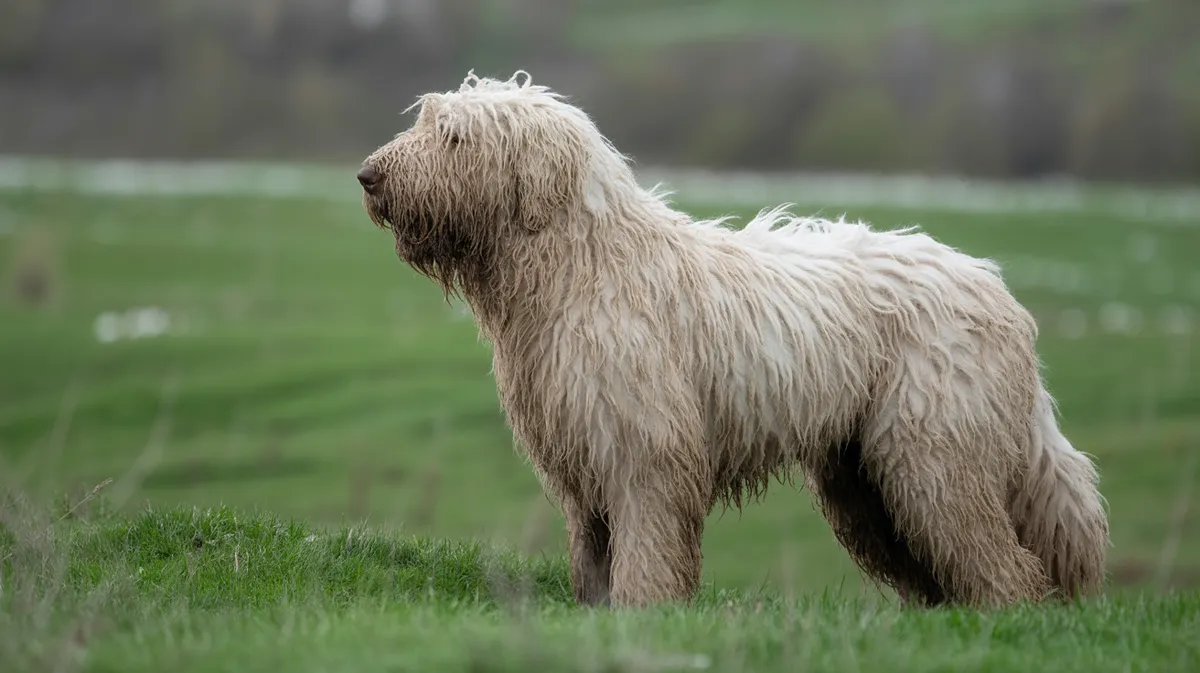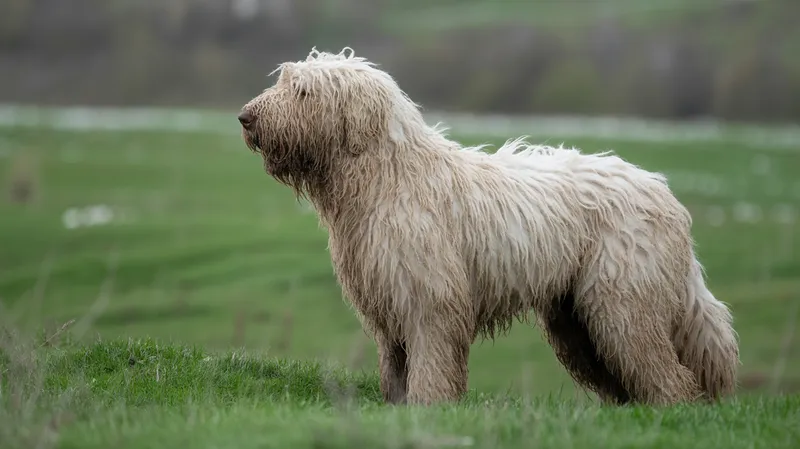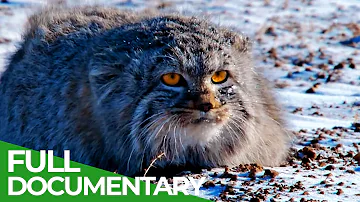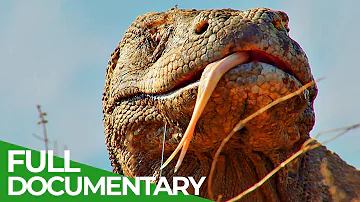
Komondor
Canis lupus familiaris

Meet the Komondor
The Komondor is a large Hungarian livestock guardian dog renowned for its distinctive corded coat resembling long, white dreadlocks. This unique fur offers protection from harsh weather and potential predators, making the breed highly valued by shepherds for centuries. Komondors are intelligent, independent, and protective, traits honed through generations of working alongside flocks. While they are calm and affectionate with their families, they are naturally wary of strangers, making them excellent watchdogs.
Classification
Mammal
Habitat
Grassland (domesticated, traditionally Hungarian plains)
Diet
Omnivore
Lifespan
10-12 years
Conservation
Least Concern
Weight
36–60 kg (80–132 lbs)
📖Fascinating Facts
Livestock Guardian
Komondors were bred specifically to guard sheep and cattle in the Hungarian plains, protecting flocks from wolves and other predators.
Corded Coat
Their iconic corded coat naturally forms into long, rope-like cords that provide insulation and protection from animal attacks.
Hungarian Heritage
The Komondor is one of Hungary's most beloved native breeds and is officially recognized as a national treasure.
📋Detailed Description
The Komondor is a robust, powerfully built dog breed, typically standing 65–80 cm (25–31 in) at the shoulder and weighing between 40–60 kg (88–132 lbs), with males generally larger than females. Its most distinctive feature is the dense, corded white coat, which forms naturally into tassel-like cords as the dog matures, reaching full length by 5–6 years of age. This coat serves as both insulation against extreme temperatures and as armor against bites from predators such as wolves. Komondors have a broad, muscular body, deep chest, and a strong, slightly arched neck. Their head is large and expressive, with dark, almond-shaped eyes and pendant ears that blend into the coat. Behaviorally, Komondors are highly intelligent, independent thinkers, a trait developed from centuries of working autonomously to guard livestock. They are known for their calm and steady demeanor with family, but display acute vigilance and assertiveness when faced with potential threats. Socially, they are reserved with strangers but form strong bonds with their human families and animals under their protection. Reproduction in Komondors is typical of large dog breeds, with litters averaging 6–10 puppies. Puppies are born with soft, wavy coats that begin to cord as they grow. The breed matures slowly, both physically and mentally, often not reaching full maturity until 3 years of age. Their longevity averages 10–12 years, with some individuals living longer under optimal care.
💡 Did you know?
The Komondor's corded coat requires extensive grooming and can take up to two years to fully develop.
🔬Research & Sources
Wikipedia Summary
The Komondor, also known as the Hungarian sheepdog, is a large, white-coloured Hungarian breed of livestock guardian dog with a long, corded coat.
Last Modified: 5/5/2025
🎭Behavior & Social Structure
Komondors are primarily nocturnal guardians, historically patrolling pastures at night to protect livestock from predators. They exhibit strong territorial instincts and will patrol boundaries regularly, using their acute senses of hearing and smell to detect intruders. Unlike herding breeds, Komondors do not drive livestock but instead position themselves strategically to observe and respond to threats. Feeding behavior is typical of large domestic dogs, with a diet consisting of high-quality commercial or home-prepared food, though historically they would have scavenged or been fed leftovers. Social interactions are marked by a clear hierarchy; Komondors are dominant but not aggressive without provocation. They are generally tolerant of other animals within their 'flock' but may be combative with unfamiliar dogs. Daily routines include periods of rest interspersed with alert patrols, especially in environments where their guarding instincts are engaged.
👶Reproduction & Life Cycle
Komondors reach sexual maturity between 18–24 months, though responsible breeding is typically delayed until at least 2 years of age to ensure physical and mental maturity. The breed exhibits no pronounced seasonality in estrus, but most breeding in Hungary traditionally occurred in late winter or early spring to coincide with favorable weather for whelping. Gestation lasts approximately 63 days. Females exhibit strong maternal instincts, preparing a den-like area for whelping and providing attentive care to their puppies. Litters average 6–10 pups, though larger litters are not uncommon. Puppies are born with soft, curly coats that begin to cord between 8–12 months. Weaning occurs at 6–8 weeks, with socialization and exposure to livestock beginning early to foster proper guardian behavior. Both parents may participate in socializing the pups, though the female is the primary caregiver.
🛡️Adaptations & Survival
The Komondor's corded coat is a unique evolutionary adaptation, providing both thermal insulation and physical protection from bites and harsh weather. The white coloration allows the dog to blend in with sheep flocks, offering camouflage from predators. Their large size and muscular build enable them to confront and deter large predators, while their agility allows for quick, decisive movement when necessary. Behaviorally, their independence and decision-making skills are adaptations to working alone without direct human supervision. Their acute senses, particularly hearing and olfaction, are highly developed, aiding in early detection of threats. The breed's calm demeanor conserves energy for sudden bursts of activity when responding to danger.
📚Research Sources
🎨Cultural Significance
The Komondor is a national treasure in Hungary, often symbolizing strength, loyalty, and rural heritage. Historically, Komondors were indispensable to Hungarian shepherds, protecting valuable livestock from wolves and thieves. Their image appears in Hungarian folklore, literature, and art, often depicted as noble and courageous guardians. The breed is sometimes referred to as the 'King of the Hungarian Sheepdogs' and has been recognized as a national breed since the early 20th century. In modern times, Komondors are celebrated at dog shows and cultural festivals, and their unique appearance has made them popular in media and advertising, though their working heritage remains central to their identity.
🔬Recent Research & Discoveries
Recent genetic studies have confirmed the Komondor's close relationship to other Central Asian livestock guardian breeds, supporting theories of ancient migration and breed development along pastoral routes. Ongoing research focuses on the genetics of coat cord formation, with implications for understanding hair growth and structure in mammals. Behavioral studies have examined the breed's problem-solving abilities and autonomous decision-making, highlighting their suitability for independent work. Veterinary research addresses breed-specific health concerns, particularly musculoskeletal disorders and the impact of coat maintenance on skin health. Conservation genetics projects in Hungary aim to preserve genetic diversity and document the breed's historical lineage.
🎥Wildlife Videos

Wildlife Instincts: Pallas's Cat - Master of the Plains | Free Documentary Nature
Wildlife Instinct - Episode 1: Pallas's Cat - Master of the Plains | Free Nature Documentary Watch "Wildlife Instincts: Survival ...
Free Documentary - Nature

Wild Indonesia | Episode 3: Land of Dragons | Free Documentary Nature
Wild Indonesia - Episode 3: Land of Dragons | Wildlife Documetary Watch 'Wild Indonesia - Episode 1' here: ...
Free Documentary - Nature

Wildlife - The Fascinating World of Wild Animals | Full Series | Free Documentary Nature
Wildlife - The Fascinating World of Wild Animals | Wildlife Documentary Watch 'Ocean Stories - Full Series' here: ...
Free Documentary - Nature

Wildlife | Episode 3: Kangaroos - Kings of the Outback | Free Documentary Nature
Wildlife - Episode 3: Kangaroos - Kings of the Outback | Wildlife Documentary Watch 'Wildlife - Episode 4: World's Largest Land ...
Free Documentary - Nature

Wild Colombia - Fantastic Creatures | The Lost Eden | Free Documentary Nature
Wild Colombia - Fantastic Creatures | The Lost Eden | Free Documentary Nature Watch 'Wild Colombia Revealed' here: ...
Free Documentary - Nature

David Attenborough | Nature Documentary To Fall Asleep To (ai)
"Life on Earth" is your gateway to the breathtaking world of wildlife and natural wonders. Through captivating documentaries, we ...
Life on Earth - David Attenborough
🌍Habitat Information
The Komondor typically inhabits Grassland (domesticated, traditionally Hungarian plains) environments. Komondors have adapted to their environments with specialized features and behaviors.
Primary Habitat:
Grassland (domesticated, traditionally Hungarian plains)
More detailed habitat information will be available soon.
🛡️Conservation Status
The Komondor is currently classified as Least Concern. Conservation efforts are crucial for preserving this species for future generations.
Common Threats:
- 🏠Habitat loss and fragmentation
- 🌡️Climate change impacts
- 🎯Hunting and poaching
- 🏭Human-wildlife conflict
⚠️Threats & Conservation Challenges
The Komondor is not considered at risk globally, but the breed faces several challenges. Modern changes in agricultural practices and the decline of traditional shepherding have reduced demand for livestock guardian dogs, leading to decreased breeding populations in Hungary and elsewhere. The breed's unique coat requires significant maintenance, which can deter potential owners and lead to neglect or improper care. Genetic bottlenecks and inbreeding are concerns in some populations, potentially increasing susceptibility to hereditary diseases such as hip dysplasia and entropion. Urbanization and the unsuitability of the breed for non-rural environments can result in behavioral problems or abandonment. Conservation efforts focus on maintaining genetic diversity and promoting responsible ownership.
🔬Scientific Classification
Scientific Name
Canis lupus familiaris
Classification Hierarchy
🔍 About Taxonomic Classification
Taxonomic classification is a hierarchical system used by scientists to classify and organize living organisms based on shared characteristics and evolutionary relationships.
The system moves from broad categories (Kingdom) to increasingly specific ones, with each animal's scientific name typically consisting of its Genus and species.
📝Community Notes
Share your observations and insights about the Komondor with our community of wildlife enthusiasts.
Join Our Community
Sign in to share your observations and connect with fellow wildlife enthusiasts.
Sign In to ContributeNo community notes yet
Be the first to share your observations about the Komondor!
Explore Komondor
Select a tab above to learn more about this amazing animal.
📸Photo Gallery
No photos available for this animal yet.
🌟Discover More Wildlife
Continue your journey of discovery with more fascinating animals from our database
